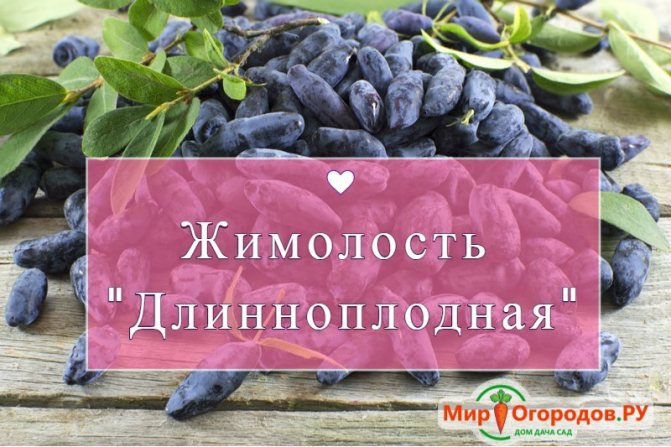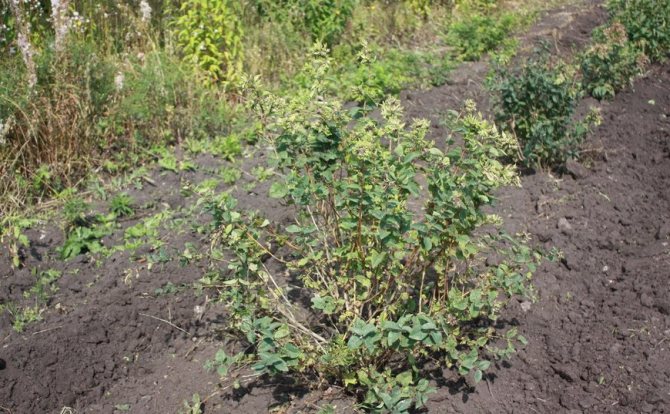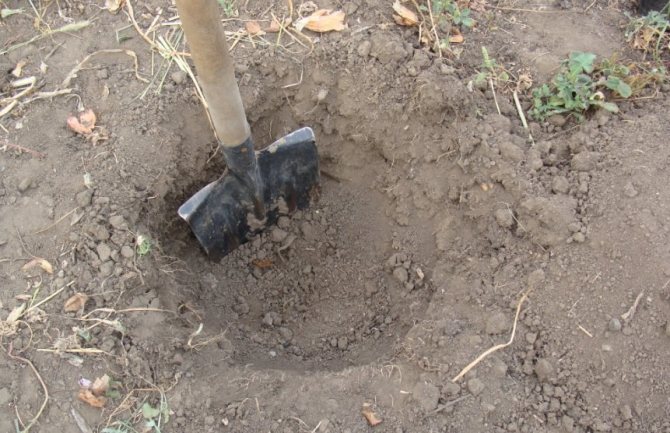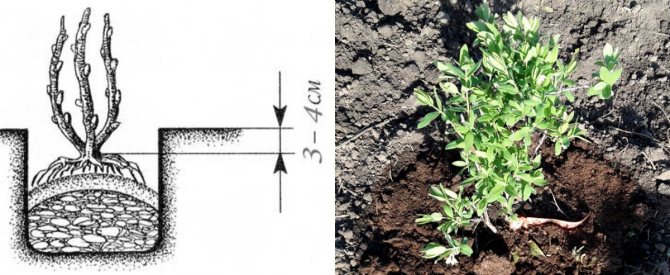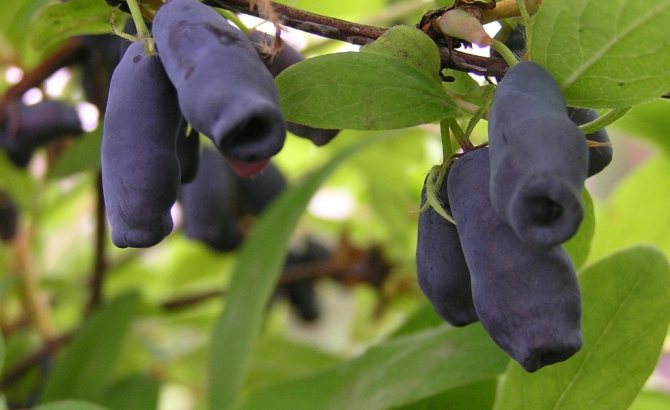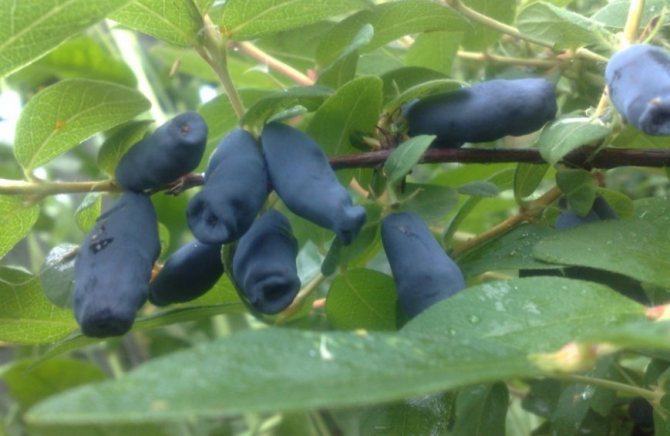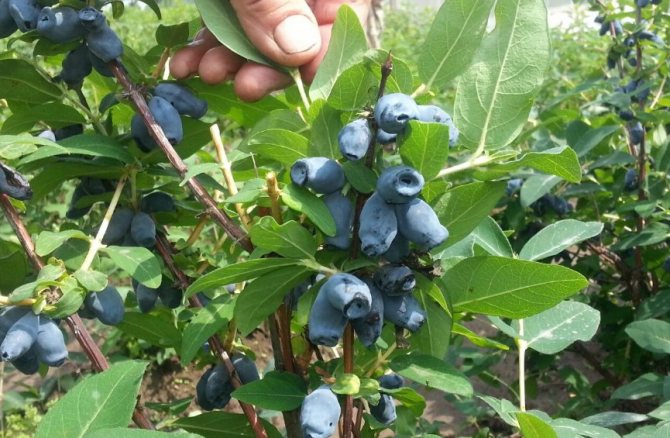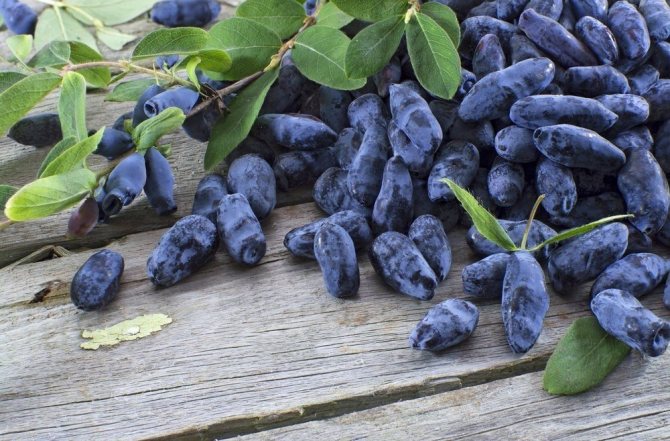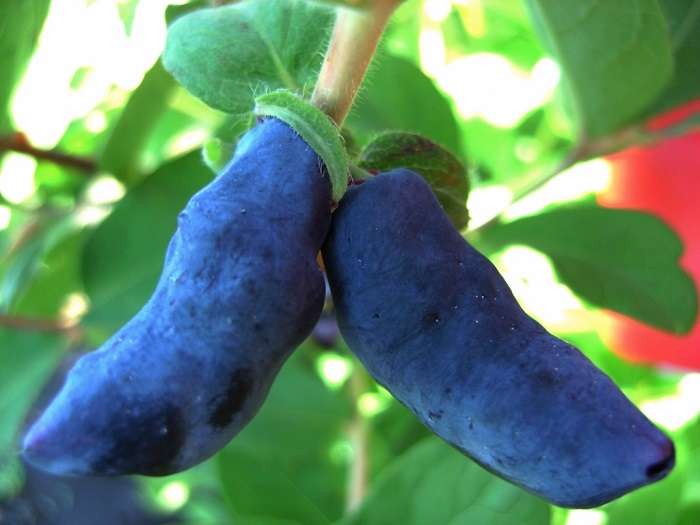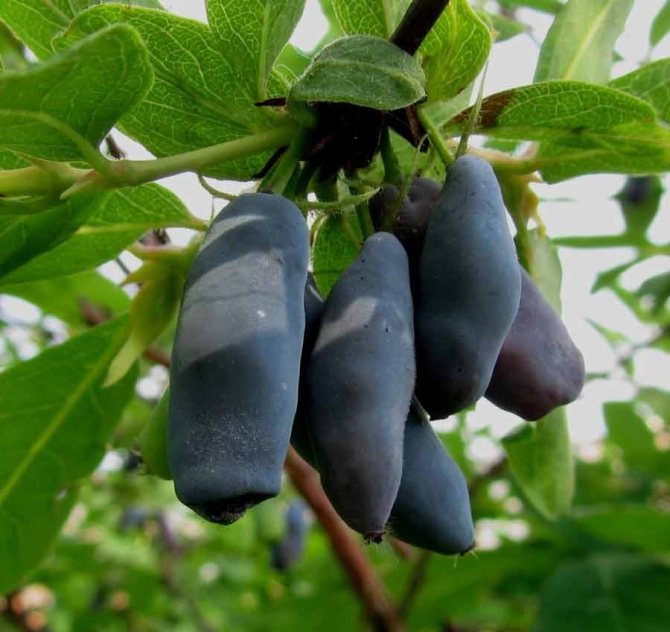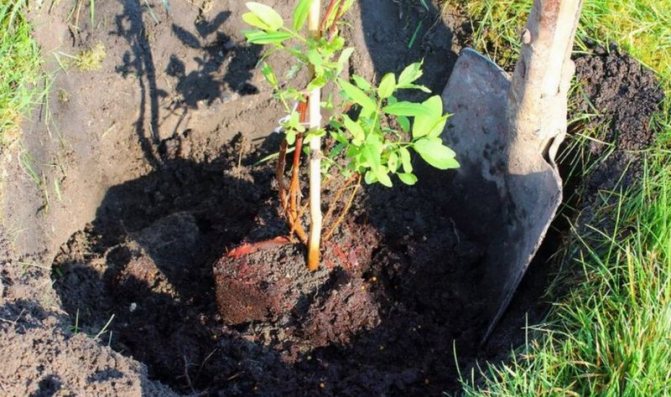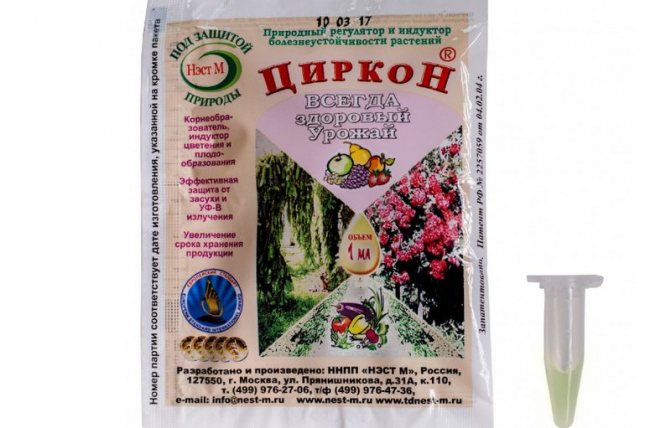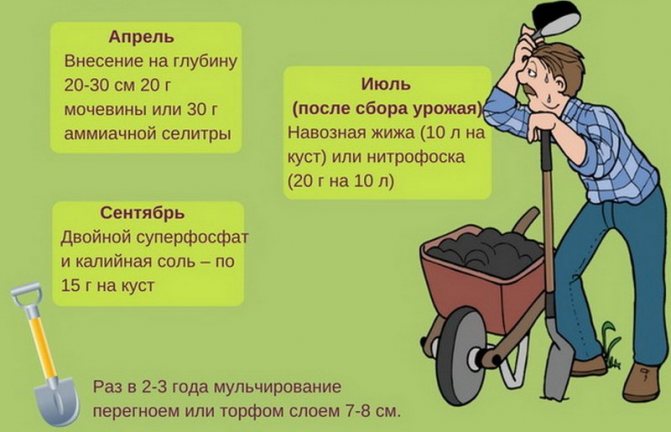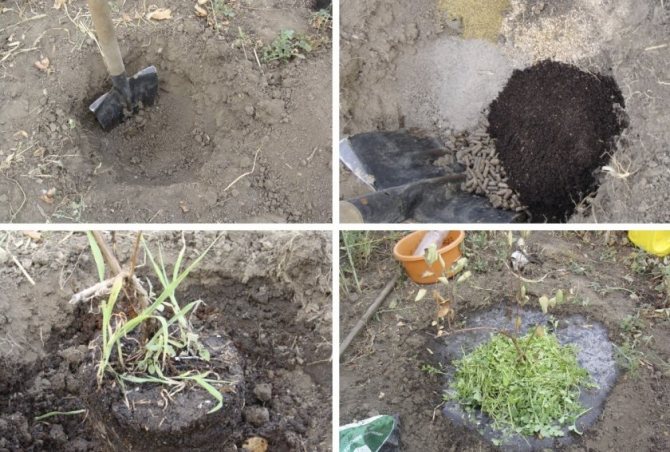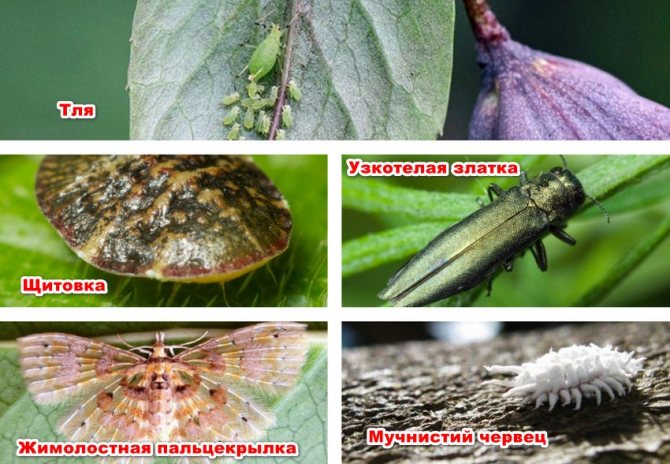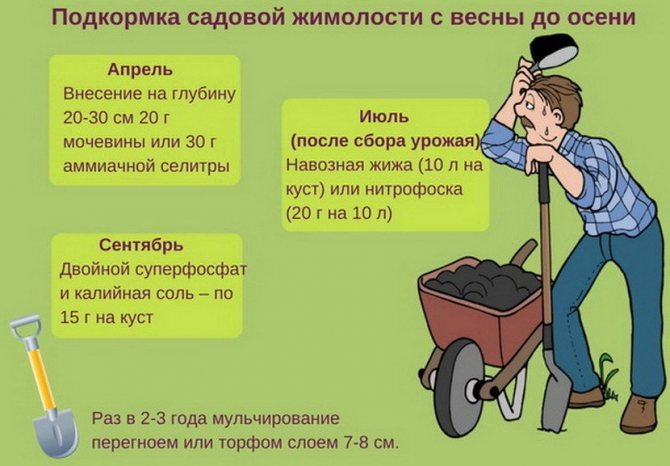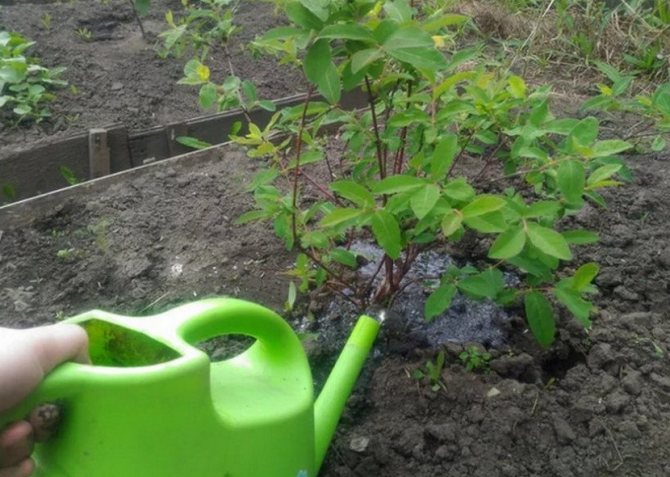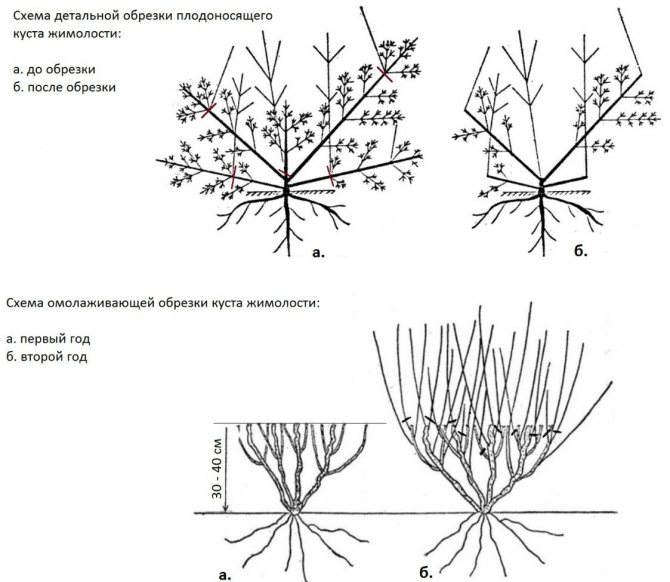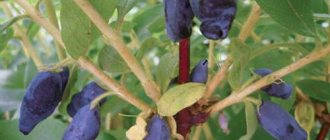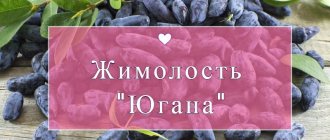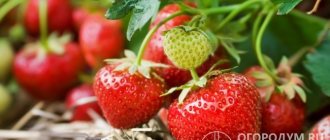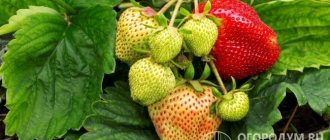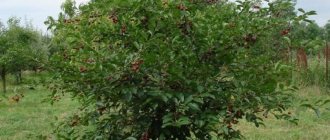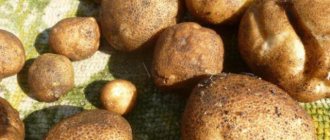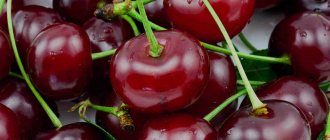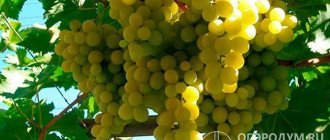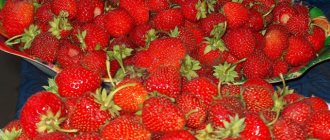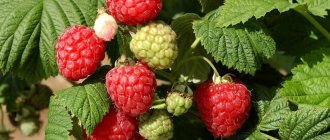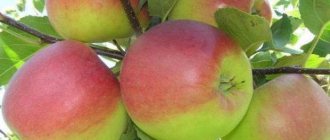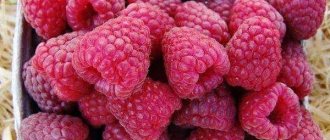Honeysuckle is a forest dweller, therefore, 20 years ago, few grew it at their summer cottages, but today varieties of cultivated bushes are found in almost every site and are the pride of Russian breeders. What are the edible varieties of this vitamin berry, we suggest finding out further.
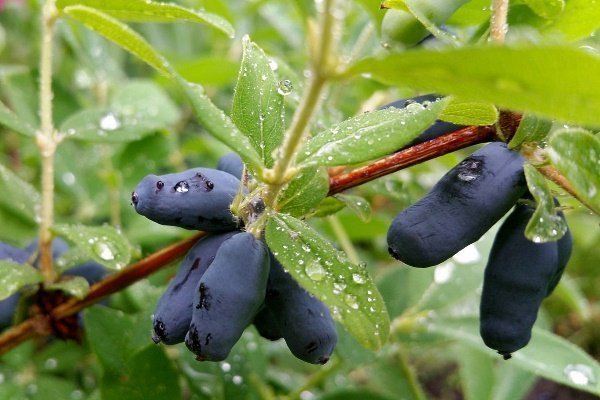
Bakchar giant
This variety is suitable for planting in different regions of Russia, as it tolerates frost and heat well. It does not have a high yield, but it has very large fruits weighing up to 2.5 grams and up to 4 cm long, which have a pronounced aroma.
Harvesting should be extremely careful, it is advisable to spread cloth or polyethylene under the bush, since ripe berries crumble very easily.
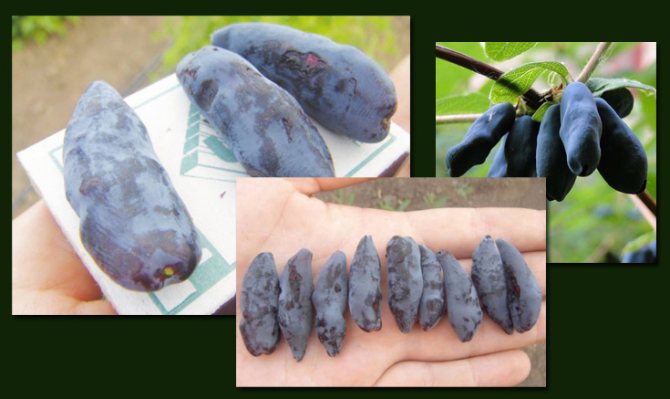

"Bakcharsky giant" grows up to 2 meters in height and has a beautifully designed oval crown. It grows and develops better if you regularly weed the nearby weeds.
Harvesting and storage
A week after the berries have turned blue, they are ready to be harvested. Since the fruits of "Long-fruited" are prone to shedding, a film or cloth is spread under the bush before harvesting. Honeysuckle is removed by hand or by shaking it off immediately in the container. In the second case, only ripe berries will be in the baskets. Fruits that have fallen to the ground during harvest are used to make various preparations or homemade wine. Fresh honeysuckle is not stored for more than two days, even in the refrigerator. Therefore, they try to process the fruits that have not been eaten as quickly as possible. In order to preserve the berries as long as possible, it is recommended to adhere to the following rules:
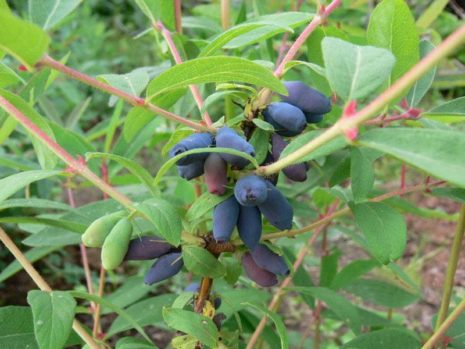

- the collection is carried out in dry weather, waiting for the berries to dry from the dew;
- well ventilated baskets or drawers are used for collection;
- the bottom of the containers should be wide and the sides low;
- the harvested berries are immediately transferred to the refrigerator on the fruit and vegetable shelf.
Leningrad giant
The variety got its name due to the fact that it was bred by biologists from St. Petersburg. It is a tall shrub up to 2.5 meters with a rounded crown. Resistant to many diseases and temperature extremes.
The fruits are very large, weighing up to 4 grams and up to 3.5 cm long, the surface is fairly uniform without obvious tuberosity. The main difference of the variety is that the berries grow in bunches and stick tightly to the branch, which greatly facilitates the harvesting procedure. The first fruits can be obtained no earlier than 3 years after planting. It is well pollinated when grown together with the varieties "Morena", "Malvina", "Blue Bird".
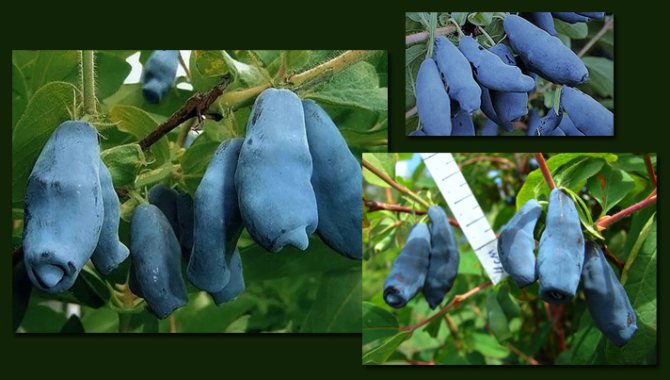

The berries of the "Leningrad giant" are best suited for winter harvesting, which will be an excellent means of preventing colds due to their high content of ascorbic acid.
Outcomes
For successful cultivation and obtaining a full-fledged harvest, you need to pay attention to the following points in caring for Lakomka honeysuckle:
- Find a landing site according to the recommendations.
- Choose healthy seedlings with closed roots.
- Land according to the instructions.
- Plant several varieties of pollinators nearby.
- Produce the necessary watering, loosening, mulching and weed removal.
- Feed the bushes three times per season.
- Perform sanitary pruning in the spring.
- Cover young plants for the winter.
Delight
The variety was bred in 2012, the bush reaches about 1.7 meters in height and has a rounded shape of branches woven into the crown. Gardeners love him for the fact that already in the year of planting in the second half of June, he begins to bear its first fruits. Their value directly depends on the sun. With sufficient light and sunny weather, the berries grow weighing up to 2.6 grams. They have a sweet taste and a tart aroma.
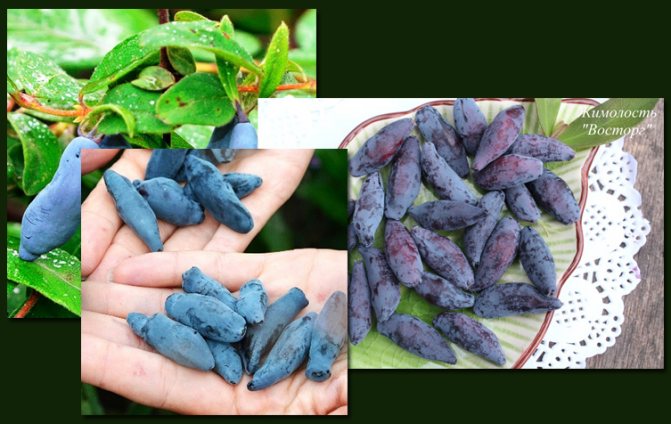

Due to the dense waxy bloom, the berries tolerate transportation well and are stored for a long time.
Pollinators
To obtain a good harvest, the Long-fruited must interact with other species. Otherwise, the yield indicators will be minimal.
The best pollinators of the variety:
- Moraine;
- Chelyabinka.
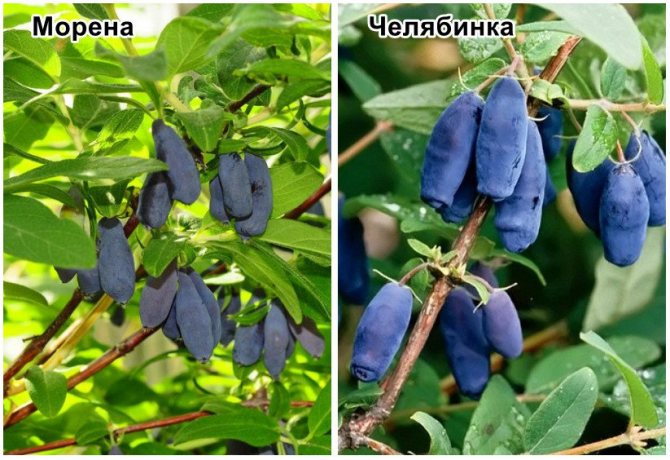

Good pollinators:
- Zest;
- Sineglazka;
- Blueberry;
- Enchantress.
Yugan
This self-fertile variety was bred in 2010 in the Tomsk region. The bush is relatively low (up to 1.5 m) and spreading. The nearby varieties "Giant's Daughter" and "Delight" will increase its fertility. The berries are sweet, large, weighing up to 2 grams and up to 4 cm long. On a branch, unripe fruits hold very tightly, but ripe fruits easily crumble, therefore, when collecting, it is recommended to lay a cloth or polyethylene under a bush.
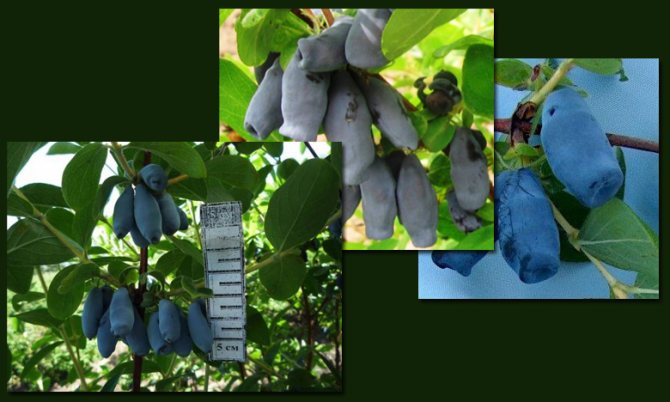

This variety is characterized by uneven ripening of berries, which depends on the climate.
Agrotechnics
Gourmet is an unpretentious variety, but it will be possible to achieve good plant development and abundant yields only if agrotechnical requirements are met.
Choosing a place in the garden and preparing holes
The landing site for Gourmands should be well lit, protected from wind and drafts.
Reference. On bushes growing in the shade, the berries grow smaller and sour.
This is a moisture-loving culture, but in the case of waterlogged soil, the risk of rotting of the root system increases. Therefore, before planting seedlings, the groundwater level is checked - it should be at least 1-1.5 m.
Preparing for landing
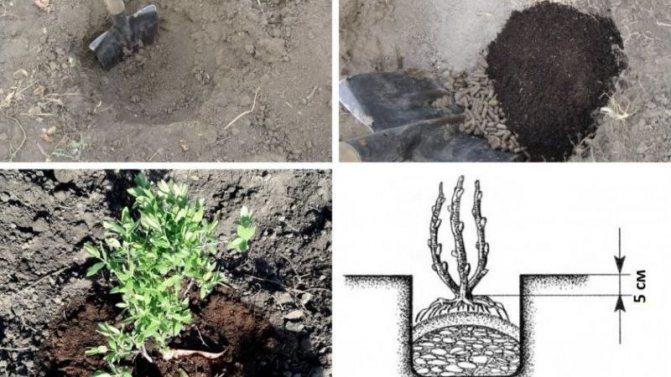

For planting, choose biennial seedlings with a height of about 30 cm with a developed underground part, in which the length of the rhizome is about 25 cm, there are several above-ground shoots with buds and there are no signs of diseases or pests.
15-20 days before planting, the site is cleared of weeds and plant residues, dug up and fertilized into the soil: 10 kg of manure or humus, 30-60 g of superphosphate, 20-30 potassium salt per 1 sq. m.
Ground requirements
The variety grows well in light, fertile soil with good aeration, moisture permeability and neutral acidity. The most suitable option is loam and sandstone.
Reference. Lime or dolomite flour is added to the over-acidified soil before planting.
Timing, scheme and landing rules
The gourmet is planted in the ground from the beginning of September to the end of October, while there should be at least three weeks before the onset of stable frosts.
Landing rules:
- Dig planting holes 50 × 40 cm in size in the prepared area.
- Pour a layer of drainage from crushed stone or broken brick on the bottom of each, and a nutritious soil mixture on top (2-3 shovels of excavated earth, a bucket of humus, 200 g of wood ash and 30 g of superphosphate).
- Form a small hill in each hole and install a seedling on it, spreading its roots.
- Sprinkle the plant with soil, compact it slightly and water (a bucket of water on the bush).
- When the ground subsides after watering, add more soil so that the root collar is 7 cm above the surface.
- Mulch the root zone with peat.
The distance between bushes should be 2 m, between rows - at least 1 m.
Features of cultivation and nuances of care
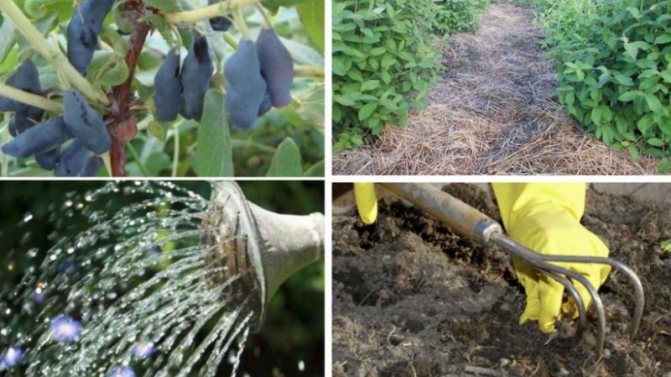

In spring and summer, plants are watered every two days at the rate - a bucket of water for each bush. In hot and dry weather, the water consumption is increased to two buckets per bush. In the fall, watering is stopped.
After each watering or rain, the soil is loosened to improve the access of moisture and air to the roots. At the same time, the site is weeded, removing weeds, which provoke high humidity and the development of diseases.
Provided that the bushes are planted in fertilized soil, they begin to feed the plants in 2-3 years. At the beginning of spring, 5-7 kg of humus is applied under each bush, and in the fall - potassium-phosphorus fertilizers (superphosphate, kainite).
For bushes under 10-12 years old, only sanitary pruning is carried out, removing all dry, damaged and frozen shoots in the spring (end of March). Adult bushes rejuvenate - they completely remove all branches or leave some of the strongest ones.
Also, during the season, the crown of the bush is formed - they thin out the thickened areas, remove old shoots that do not bear fruit, shorten the young ones to improve branching.
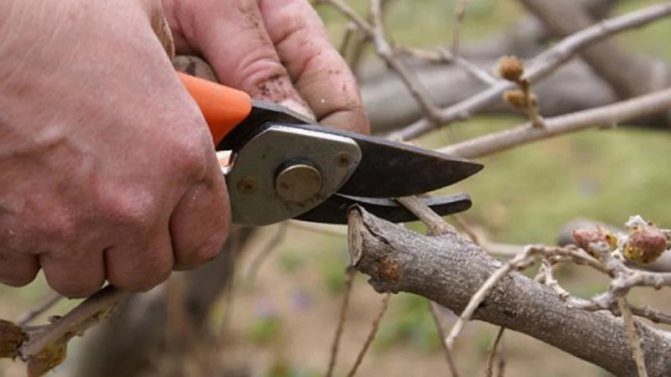

Pollinators
Since the variety is self-fertile, 2-3 other honeysuckle varieties are planted nearby for cross-pollination.
The best pollinators for Gourmet:
- Nymph;
- Blue spindle;
- Blue bird;
- Malvina;
- Kamchadalka;
- Nizhny Novgorod early;
- Moraine;
- In memory of Kuminov;
- Start.
Disease and pest control
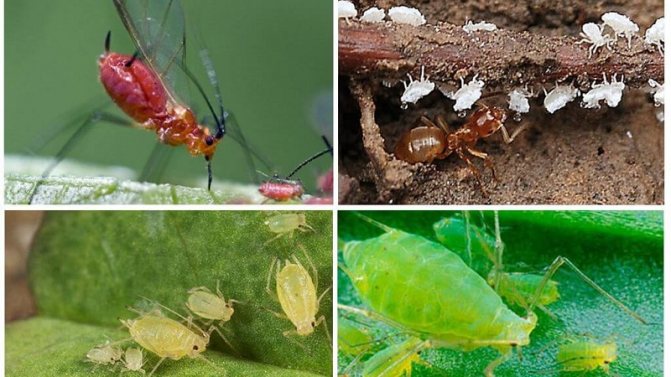

Diseases and pests dangerous for Gourmet:
| Disease, pest | Signs | Treatment / prevention |
| Cercosporosis | White spots with brown edging appear on the leaves. | Plants are treated with fungicidal preparations: "Skor", "Vectra", "Fundazol", "Cumulus", "Topaz". |
| Powdery mildew | White powdery bloom is visible on the leaves. | |
| Mosaic | Leaves become small, develop poorly. | Plants cannot be cured. The infected bushes are dug up and burned. |
| Aphid | The pest feeds on the juice of shoots and leaves, which slows down the growth and development of plants, and decreases productivity | Treatment of bushes with insecticidal or insecticidal acaricidal preparations, for example, "Aktellik", "Fufanon", "Aktara", "Eleksar" or "Inta-Vir". For prevention, plants are treated with "Lepidocide" or "Confidor". |
| Shields | Small insects sucking juice from shoots. As a result, the bushes dry up and die. | |
| Mites | Dark spots form on the leaves; at the end of summer, the leaf plates turn brown and dry out. |
Preparing for winter
In the fall, the bushes stop watering so that they stop growing and go into a dormant phase, they prune and burn the cut parts of the plants. The site is cleared of fallen leaves, weeds and other debris and dug up, and the bushes are treated from pests and diseases.
Young plants are covered with protective material and covered with snow; adult bushes do not need winter shelter.
Reproduction
Gourmand is propagated by vegetative methods: cuttings, dividing a bush or layering.
When propagating by layering in early spring or late autumn, a lower one-year shoot is chosen on an adult bush, bent to the ground, fixed, sprinkled with soil and watered regularly. Six months later, an independent root system is formed on it, after which the shoot is separated from the mother plant and planted in a permanent place.
Dividing the bush - the simplest breeding method for honeysuckle. In the fall, an adult, overgrown bush is dug up and divided into several parts so that each one has developed shoots and root processes. Delenki are planted in the ground and looked after like adult plants.
For grafting in early March, cuttings with a thickness of 0.4-0.5 cm and a length of 7-12 cm with 2-3 pairs of leaves and at least one internode are cut from lignified shoots. They are planted in a peat-sand mixture, deepening by 1-2 cm, covered with foil and kept at a temperature of + 20 ... + 25 ° C. Rooting occurs after 10 days.
Amphora
This variety was bred by Pavlovsk biologists for the cold regions of Russia. It is ideal for growing in the colder regions of our country.
The bush reaches 1.5 in height, and its bark has a crimson hue, so it is often used for landscaping personal plots.


The fruits have practically no aroma, the taste is sour with hints of bitterness. They do not crumble and have a thick skin.
The variety does not have a high yield and begins to bear fruit in the 3rd year of planting, but it tolerates low temperatures well and gives a harvest even with a small amount of sunny days and heat. It is well pollinated when planted together with the varieties "Nymph", "Arena", "Altair".
Decorative views
In addition to edible honeysuckle species, which are bred for the sake of obtaining tasty and healthy fruits, there are also decorative varieties. Their berries are inedible, and sometimes poisonous, but the flowers are very effective and have a pleasant aroma. Such shrubs are used in landscape design, hedges, to decorate gardens and gazebos. Curly specimens are especially effective in this regard.
The most popular are the following types:
- Brown;
- Serotin;
- Japanese;
- Tatar;
- Korolkov;
- Honeysuckle.
Honeysuckle and Brown's honeysuckle are curly lianas that twine everything in their path. The first has yellow-pink flowers, while Brown's honeysuckle has spectacular bright orange. Honeysuckle Tatarskaya and Korolkova are shrubs used for hedges.
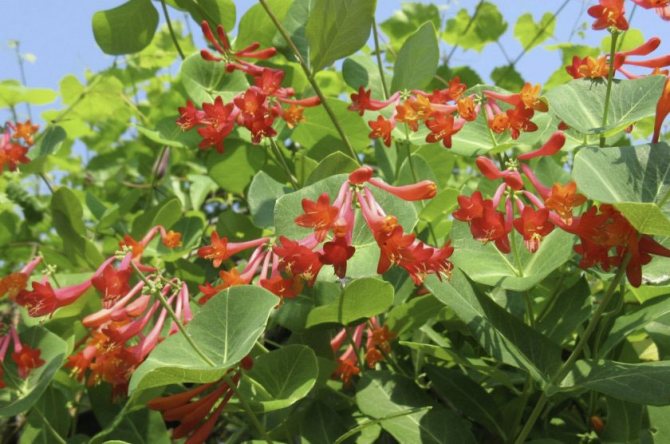

Decorative Brown's honeysuckle is used to create awnings, decorate fences, zoning areas
Bazhovskaya
This variety of honeysuckle was bred in the Urals by crossing Kamchatka and Altai species. Fruiting late, no earlier than the fourth year of planting, but the berries have a pronounced sweet taste. Bitter notes can appear due to insufficient watering during dry summers.
The bush is spreading and high (up to 2 meters). The berries are shaped like elongated barrels with an uneven surface.
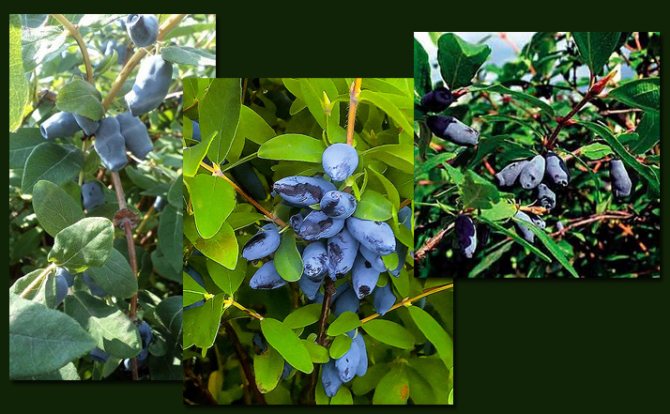

The yield is average, the berries are large enough: their weight fluctuates around 1.8 grams. They crumble easily and require timely collection.
The bush is susceptible to aphid attacks, therefore it requires additional processing.
Diseases and pests
"Long-fruited" is susceptible to such fungal diseases as: ramulariasis, powdery mildew, European cancer. If you do not take action in time, then the shrub dies within 1-2 seasons. For prevention and treatment, shrubs are treated with copper-based chemicals in early spring. Such means will protect honeysuckle from viral ailments, and destroy the larvae of parasites. During the summer season, you can carry out treatments with folk remedies and mechanically control pests.
Daughter of a giant
A high-yielding variety with large berries, the weight of which reaches 2.5 grams, and the length is 3.5 cm. A good result is obtained by pollination from the nearby varieties "Delight" or "Bakcharsky Giant".
The berries are very sweet, shaped like a lumpy pear. They firmly hold on to the branch and do not crumble during collection, which greatly facilitates the task of gardeners.
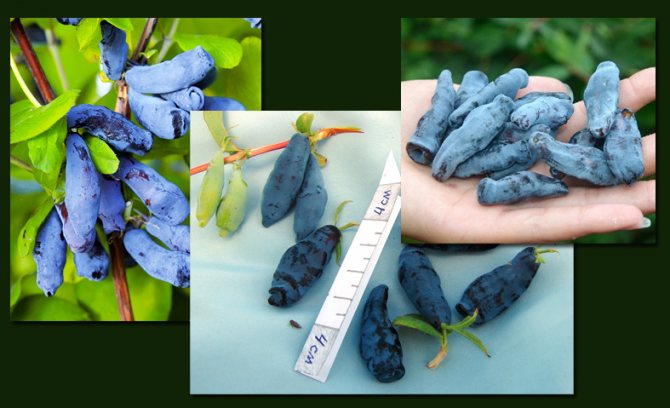

The bush of this variety is tall and sprawling, it does not require serious care, but it loses the taste properties of the fruit with insufficient watering. It tolerates frost well, does not require feeding. The crop begins to give 3 years after planting.
Preparing for the winter season
Honeysuckle "Long-fruited" does not require special preparation for winter, except for planned autumn work such as: sanitary pruning, feeding and mulching. The plant is able to withstand any, even the most severe frosts without shelter. This applies to both adult bushes and young seedlings.
Long-fruited honeysuckle is an excellent option if you want to get sweet berries in the first days of summer and at the same time decorate your plot with an attractive berry bush.
Long honeysuckle
This variety was bred for the Ural climate. It is relatively short, but spreading.The bark is purple in color, which allows you to use honeysuckle to decorate the site and create landscape compositions.
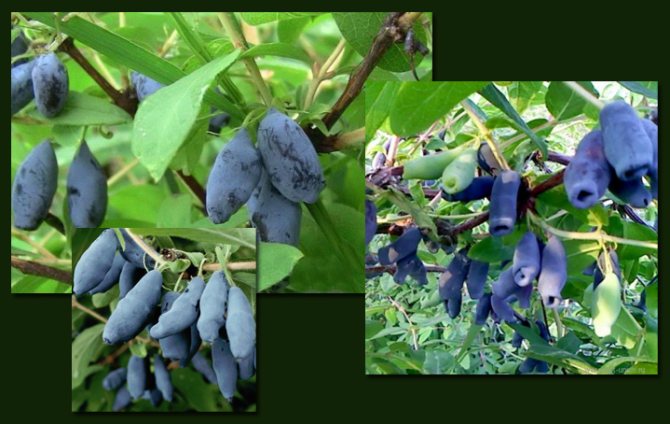

It blooms at the end of May, and already at the beginning of July-end of June, the first harvest can be harvested. The berries are long, up to 2.7 cm. Their weight can reach 2 grams. To taste, the fruits are fragrant, juicy and sweet without the bitterness inherent in some varieties. They ripen evenly and practically do not crumble.
Testimonials
Long-fruited honeysuckle is one of the many varieties growing on our site. We have been breeding this culture for a long time. This variety is one of the best in terms of its characteristics. Compact bushes produce excellent yields. In our garden, the maximum yield that we managed to collect from one bush of this variety was 3kg 800 grams. Care consists in regular watering and annual feeding.
I always wanted to grow honeysuckle on my site. It is very pleasant to enjoy fresh berries at the very beginning of the summer season. Our plot is not very large, so the choice fell on "Dlinnoplodnaya". Attracted by the small size of the bush and large berries without bitterness. Having learned that in order to obtain a harvest, several different varieties are necessary, they persuaded two neighbors to plant a bush on their plots. Now everyone is happy, we exchange the harvest and impressions of care.
There is a lot of good honeysuckle. But varieties with a complex of advantages are especially appreciated, such as the Long-fruited Ural honeysuckle selection. It will delight you with early, large and unusually tasty berries, provide a decent harvest, which will be enough to eat fresh and make jam. The plant is unpretentious, and if you rarely appear in the country, this is just what you need.
